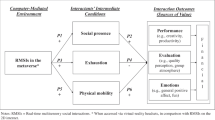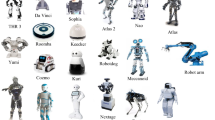Abstract
As digital communication becomes more commonplace and sensory rich, understanding the manner in which people interact with one another is crucial. In the current study, we examined the manners in which people touch digital representations of people, and compared those behaviors to the manner in which they touch digital representations of nonhuman objects. Results demonstrated that people used less force when touching people than other nonhuman objects, and that people touched the face with less force than the torso area. Finally, male digital representations were touched with more force than female representations by subjects of both genders. We discuss the implications of these data to the development of haptic communication systems as well as for a methodology of measuring the amount of copresence in virtual environments.
Similar content being viewed by others
References
Bailenson JN, Aharoni E, Beall A, Guadagno R, Dimov A, Blascovich J (2004) Comparing behavioral and self-report measures of embodied agents social presence in immersive virtual environments. Paper presented at the 7th Annual International Workshop on Presence, Valencia, Spain
Bailenson JN, Beall A, Blascovich J (2002) Mutual gaze and task performance in shared virtual environments. J Vis Comput Animat 13:1–8
Bailenson JN, Blascovich J, Beall A, Loomis J (2003) Interpersonal distance in immersive virtual environments. Pers Soc Psychol Bull 29:1–15
Bailenson JN, Swinth K, Hoyt C, Persky S, Dimov A, Blascovich J (2005) The independent and interactive effects of embodied agent appearance and behavior on self-report, cognitive, and behavioral markers of copresence in Immersive Virtual Environments. Presence: Teleoperators and Virtual Environments 14:379–393
Bailenson JN, Yee N (2005) Digital chameleons: automatic assimilation of nonverbal gestures in immersive virtual environments. Psychol Sci 16:814–819
Bailenson JN, Yee N, Brave S, Merget D, Koslow D (2007) Virtual interpersonal touch: expressing and recognizing emotions through haptic devices. Hum Comput Interact 22(3):(in press)
Bente G, Rüggenberg S, Tietz B, Wortberg S (2004) Measuring behavioral correlates of social presence in virtual encounters. Paper presented at the International Communication Association Conference, May 27–31
Blascovich J, Loomis J, Beall A, Swinth K, Hoyt C, Bailenson J (2002) Immersive virtual environment technology as a methodological tool for social psychology. Psychol Inq 13(2):103–124
Brave S, Ishii H, Dahley A (1998) Tangible interfaces for remote collaboration and communication. Proceedings of CSCW ’98: Conference on Computer Supported Cooperative Work, pp 169–178
Brave S, Nass C, Sirinian E (2001) Force-feedback in computer-mediated communication. In: Stephanidis C (ed) Universal access in HCI: Toward an information society for all, Lawrence Erlbaum Associates, Mahwah, NJ, pp 145–150
Burgoon J (1991) Relational message interpretations of touch, conversational distance, and posture. J Nonverbal Behav 15:233–259
Burgoon J, Walther J (1990) Nonverbal expectancies and the evaluative consequences of violations. Human Commun Res 17:232–265
Burgoon J, Bonito J, Bengtsson B, Ramirez A, Dunbar N, Miczo N (2000) Testing the interactivity model: communication processes, partner assessments, and the quality of collaborative work. J Manage Inf Syst 16:33–56
Chaplin WF, Phillips JB, Brown JD, Clanton NR, Stein JL (2000) Handshaking, gender, personality, and first impressions. J Pers Soc Psychol 79:110–117
Chang A, O’Modhrain S, Jacob R, Gunther E, Ishii H (2002) ComTouch: Design of a Vibrotactile Communication Device Proc. Paper presented at the ACM DIS 2002 Designing Interactive Systems Conference
Churchill EF, Snowdon D, Munro A (eds) (2001) Collaborative Virtual Environments. Digital Places and Spaces for Interaction. Springer Verlag: London, UK
Crusco AH, Wetzel CG (1984) The Midas touch: the effects of interpersonal touch on restaurant tipping. Pers Soc Psychol Bull 10:512–517
Fogg B, Cutler L, Arnold P, Eisback C (1998) HandJive: a device for interpersonal haptic entertainment. Paper presented at the CHI ‘98: Conference on Human Factors in Computing Systems
Garau M, Slater M, Pertaub D, Razzaque S (2005) The responses of people to virtual humans in an immersive virtual environment. Presence: Teleoperators and Virtual Environments 14:104–116
Goldberg K, Wallace R (1993) Denta-Dentata. Paper presented at the SIGGRAPH ‘93: International Conference on Computer Graphics and Interactive Techniques
Greenwald AG, McGhee DE, Schwartz JKL (1998) Measuring individual differences in implicit cognition: the implicit association test. J Pers Soc Psychol 74:1464–1480
Ho C, Basdogan C, Slater M, Durlach N, Shrinivasan M (1998) An experiment on the influence of haptic communication on the sense of being together. Paper presented at the BT Presence Workshop
Hoffman HG (2004) Virtual Reality Therapy. Scientific American Magazine, August 2004
Hubbard A, Tsuji A, Williams C, Seatriz V (2003) Effects of touch on gratuities received in same-gender and cross-gender dyads. J Appl Soc Psychol 33:2427–2438
Kim J, Kim H, Tay B, Manivannan M, Srinivasan M, Jordan J, Mortensen J, Oliviera M, Slater M (2004) Transatlantic touch: a study of haptic collaboration over long distance. Presence: Teleoperators and Virtual Environments 13:328–337
Lanier J (2001) Virtually there. April, 66–75. Scientific American, April, pp 66–75
Lee KM (2004) Presence, explicated. Commun Theory 14:27–50
Lee K, Nass C (2004) The multiple source effect and synthesized speech: doubly disembodied language as a conceptual framework. Human Commun Res 30:182–207
Loomis JM (1992) Distal attribution and presence. Presence: Teleoperators and Virtual Environments 1:113–119
Mantovani F (2001) Virtual reality learning: potential and challenges for the use of 3d environments in education and training. Towards cyber-psychology: mind, cognitions and society in the internet age. IOS Press, Amsterdam, ch. 12
Marsella S, Gratch J, Rickel J (2003) Expressive behaviors for virtual worlds, in life-like characters tools, affective functions and applications. In: Prendinger H, Ishizuka M (eds) Springer Cognitive Technologies Series
Meehan M, Insko B, Whitton M, Brooks F (2002) Physiological measures of presence in stressful virtual environments. ACM Trans Graph 21:645–653
Noma S, Miyasato M (1997) Embodying concept with haptic interface for thinking. Proceedings of 13th Human Interface Symposium pp 11–16
Oakley I, Brewster S, Gray P (2001) Solving multi target haptic problems in menu interaction. Extended Abstracts of ACM CHI 2001, pp 357–358
Parise S, Kiesler SB, Sproull S, Waters K (1996) My partner is a real dog: cooperation with social agents. Proceedings of Computer Supported Cooperative Work, pp 399–408
Reeves B, Nass C (1996) The media equation: how people treat computers, televisions, and new media like real people and places (reprint edition): Center for the Study of Language and Information
Rizzo A, Morie JF, Williams J, Pair J, Buckwalter JG (2004) Human emotional state and its relevance to military VR training. Paper presented at the International Conference on Human Computer Interaction
Sallnas E, Rassmus-Grohn K, Sjostrom C (2001) Supporting presence in collaborative environments by haptic force feedback. ACM TOCHI 7:461–476
Slater M (2004) How colorful was your day? Why questionnaires cannot assess presence in virtual environments. Presence: Teleoperators and Virtual Environments 13:484–493
Sproull L, Kiesler S (1986) Reducing social context cues: electronic mail in organizational communication. Manage Sci 32:1492–1512
Stephen R, Zweigenhaft R (1985) The effect on tipping of a waitress touching male and female customers. J Soc Psychol 126:141–142
Strong R, Gaver W (1996) Feather, scent and shaker: supporting simple intimacy. CHI’96 Extended Abstracts, p 444
White N, Back D (1986) Telephonic Arm Wrestling, from http://www.bmts.com/normill/artpage.html
Woodcock B (2005) MMOG Chart, from http://www.mmogchart.com/
Yee N (2006) The demographics, motivations, and derived experiences of users of massively multi-user online graphical Environments. Presence: Teleoperators and Virtual Environments 15:309–329
Author information
Authors and Affiliations
Corresponding author
Additional information
In Press, International Journal of Multimedia Tools and Applications.
Rights and permissions
About this article
Cite this article
Bailenson, J.N., Yee, N. Virtual interpersonal touch: Haptic interaction and copresence in collaborative virtual environments. Multimed Tools Appl 37, 5–14 (2008). https://doi.org/10.1007/s11042-007-0171-2
Published:
Issue Date:
DOI: https://doi.org/10.1007/s11042-007-0171-2




